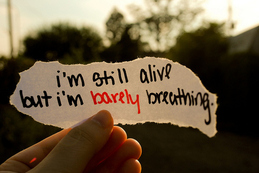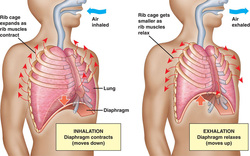
Breathing, it’s something we do all day every day, and don’t usually give much thought to. But breathing incorrectly can cause or contribute to problems such as headaches, anxiety, pneumonia, panic attacks and asthma.
In our busy lives, we can get in to some bad patterns, such as bad posture, poor diet, and not getting enough exercise. Over time, these become habit. Breathing is no different; it's something we do without much conscious thought, so it’s very easy to get in to bad habits.

There are other muscles that can also be recruited for breathing, these include the intercostals, which are muscles in between the ribs and help to expand and contract the chest, and a group of neck muscles, including the scalenes group and SCM, which work when we have a sudden intake of air, such as gasping, or rapid shallow breathing if something frightens us or we're in pain.

This is known as hyperventilation syndrome, and it's more common than you think. It can cause headaches and neck pain, increased tension and can even make pain and anxiety worse, not to mention contributing to a range of lung disorders.
This is something I see a lot in my practise; clients with headaches, muscle tension or chronic pain. They breath from the top of the chest, which means they are not getting enough oxygen, their muscles aren't given a chance to relax and the nervous system is getting pretty confused and a bit fed up trying to figure out what it's meant to be doing, so it fires off all sorts of signals which only add to the discomfort.
When this happens, I will massage all the relevant neck muscles to get them to release and stop firing off pain signals, and recommend diaphragmatic breathing exercises, which teach the body to breath from the abdomen. It takes a lot of practice, and can feel a bit strange, because you may be breaking the habit of a life time.
The easiest way to test if you are a belly breather or a chest breather is to place one hand on your breastbone and another on your belly, just below the belly button. Taking a few breaths, notice which hand rises and falls, or in what order they move. If you are belly breathing, your bottom hand should move, while your top hand should barely move. If your top hand is moving, try pushing your belly out when you go to breath in - it'll give the muscles a better idea of what they are meant to be doing.
Below is a link to a very well written and easy to follow diaphragmatic breathing exercise. For best results, try to allocate 10 minutes every day to practice this. It does take practice, but you should feel some differences in your body, your sleep quality, and stress levels quite quickly.
http://www.cchs.net/health/health-info/docs/2400/2409.asp?index=9445

 RSS Feed
RSS Feed
